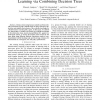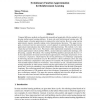688 search results - page 68 / 138 » Using reinforcement learning to adapt an imitation task |
IROS
2006
IEEE
14 years 1 months ago
2006
IEEE
Abstract— Decision trees, being human readable and hierarchically structured, provide a suitable mean to derive state-space abstraction and simplify the inclusion of the availabl...
ACL
2010
13 years 5 months ago
2010
In this paper, we address the task of mapping high-level instructions to sequences of commands in an external environment. Processing these instructions is challenging--they posit...
FLAIRS
2008
13 years 10 months ago
2008
Although several researchers have integrated methods for reinforcement learning (RL) with case-based reasoning (CBR) to model continuous action spaces, existing integrations typic...
CORR
2011
Springer
13 years 2 months ago
2011
Springer
Modeling the behavior of imperfect agents from a small number of observations is a difficult, but important task. In the singleagent decision-theoretic setting, inverse optimal co...
CORR
2010
Springer
13 years 8 months ago
2010
Springer
Temporal difference methods are theoretically grounded and empirically effective methods for addressing reinforcement learning problems. In most real-world reinforcement learning ...


